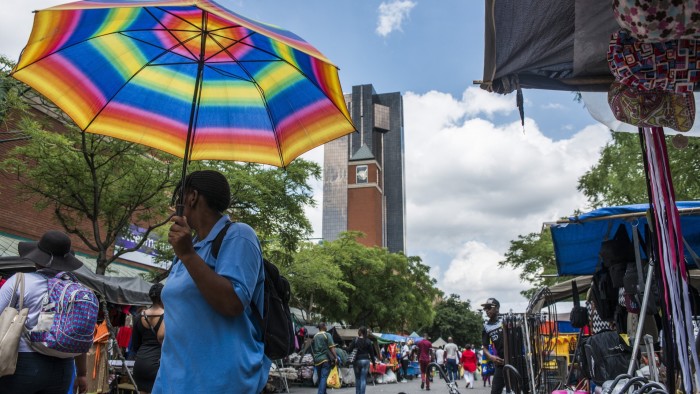Unlock the Editor’s Digest free of charge
Roula Khalaf, Editor of the FT, selects her favorite tales on this weekly e-newsletter.
Buyers are pushing for South Africa’s authorities to endorse a plan by its central financial institution to chop its inflation goal for the primary time this century, within the hopes it can completely decrease the borrowing prices of Africa’s most industrialised nation.
Portfolio managers stated a rally in South African bonds and the rand in latest weeks has partly mirrored bets that the nation’s treasury will log out by early subsequent yr on decreasing the South African Reserve Financial institution’s official inflation goal to three per cent from 3 to six per cent at the moment.
Asset managers, hedge funds and others have been getting ready for missives and conferences with the Nationwide Treasury to again the change, with some advising that it’ll want a cautious transition, stated individuals accustomed to the matter.
At stake is among the most vital levers for managing South Africa’s economic system and probably lifting it out of years of stagnation.
South African inflation remained under 3 per cent in Might, whilst rates of interest are at the moment 7.25 per cent.
The bottom charge means the prime lending charge used to cost South African financial institution loans and mortgages is near 11 per cent. It additionally feeds into yields on authorities bonds, that are about 10 per cent for 10-year debt.
The higher finish of South Africa’s goal is comparatively excessive by the requirements of huge growing nations, equivalent to Brazil, which since 2018 has reduced its inflation goal from 4.5 per cent to three per cent, with a ‘tolerance vary’ of 1.5 per cent on both facet.
Supporters of a decrease goal in South Africa say its central financial institution’s robust report in conserving inflation low in recent times has made it the fitting time to align the nation with different rising markets which have used decrease targets to assist anchor funding.
Decrease rates of interest would assist scale back debt prices for South Africa because it grapples with the long-term risk a weak economic system poses to public funds.
“If you wish to do it, there’s hardly a greater time than now,” stated an investor who lately attended conferences on the topic with officers, citing low inflation, a buoyant rand, and powerful commerce equivalent to a revival in costs for gold and platinum — two key exports for South Africa.
However transitioning to a decrease goal is also a political minefield for President Cyril Ramaphosa’s fragile coalition authorities, which wanted three makes an attempt to cross a finances this yr due to divisions amongst events on financial coverage.
Expectations for value and wage will increase must be rigorously managed in South Africa’s deeply unequal post-apartheid society.
The central financial institution used a financial coverage resolution in Might to model how it could probably have acted had the decrease inflation goal been in place.
“Inflation focusing on has been in South Africa for 25 years. That is our greatest probability in 25 years,” Lesetja Kganyago, governor of the South African Reserve Financial institution instructed the Monetary Occasions.
He in contrast doubts about South Africa’s skill to combat inflation to the so-called worry of floating in central banking, when policymakers hesitate to desert long-held fastened alternate charges.
“You’ve got a central financial institution that may swim, so it might preserve this inflation down . . . no one will drown,” he stated.
The financial institution estimates that the ‘sacrifice ratio’ of a change, or how a lot development may be sacrificed via completely different financial coverage to hit the goal, is nearly zero as a share of GDP, although some analysts contest this.
“The excessive and vast inflation goal retains long-term inflation dangers increased than they should be, miserable financial development and deepening inequality,” a paper by the financial institution’s economists stated in Might.
The Reserve Financial institution has already de facto focused 4.5 per cent inflation, or the midpoint of the present goal, since 2017. Kganyago turned governor in 2014.
One key problem of introducing a decrease goal could be for Ramaphosa’s African Nationwide Congress, the largest occasion within the coalition, to restrain wage will increase for civil servants and value hikes by state firms and municipalities.
“It’s important to get geese in a row, this isn’t a easy change — there’s a enormous quantity of political socialisation work to try this the market doesn’t think about,” stated Peter Attard Montalto, managing director at South African consultancy Krutham.
South Africa’s public sector workforce is dominated by commerce unions that usually negotiate wages based mostly on latest inflation numbers. This might make it onerous to mattress in a brand new goal, stated Daan Steenkamp, head of Codera Analytics, an financial analysis agency.
A couple of third of South Africa’s basket of client costs can be influenced by authorities, equivalent to utilities, public transport, and schooling, he added.
‘Administered’ costs, set by authorities our bodies or regulators, nonetheless usually outpace general inflation. “Which means authorities buy-in is vital if we’re to have a decrease inflation goal,” Steenkamp stated.
The Nationwide Treasury didn’t reply to a request for remark.

